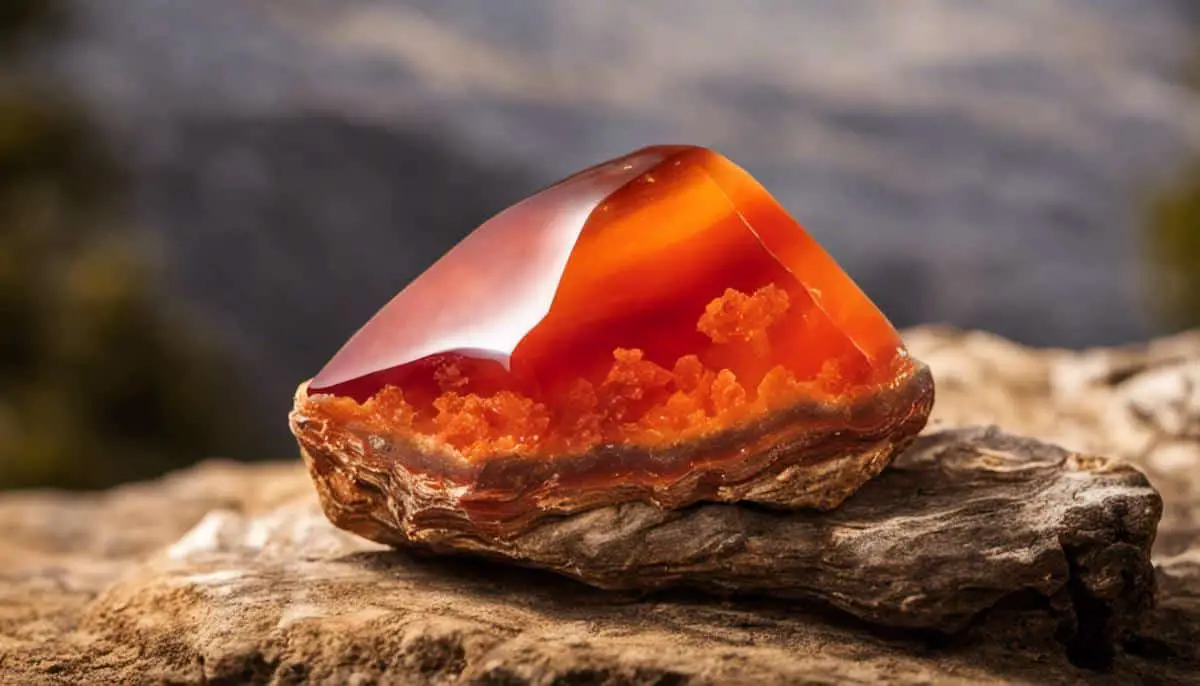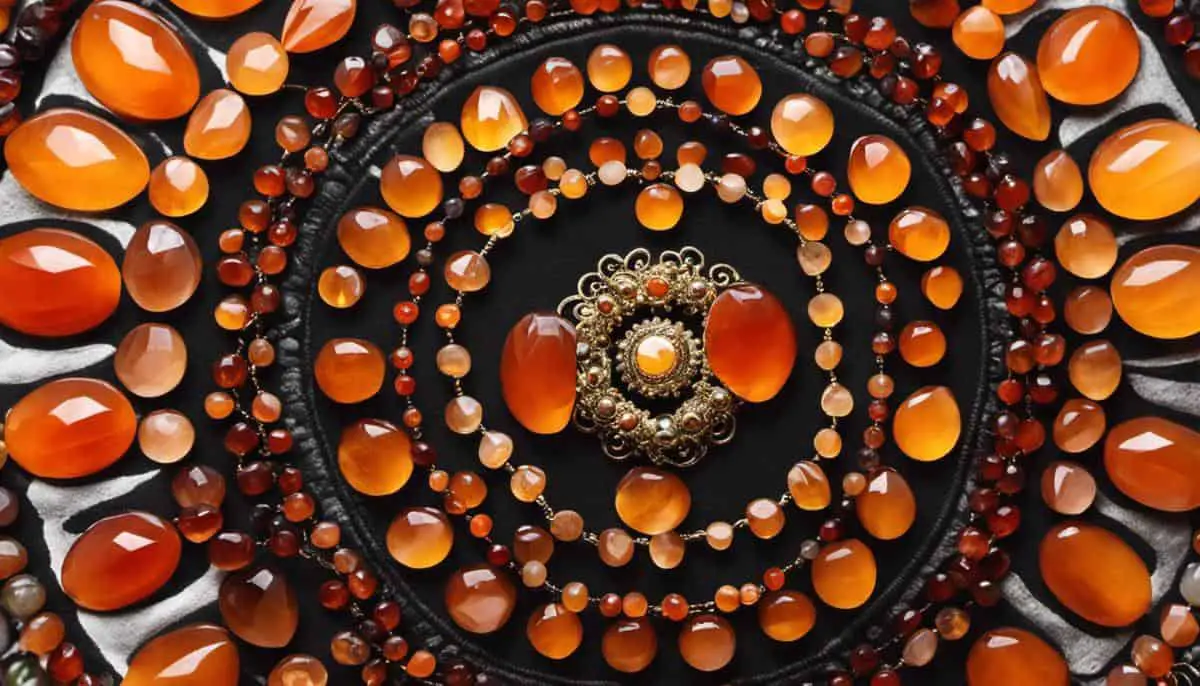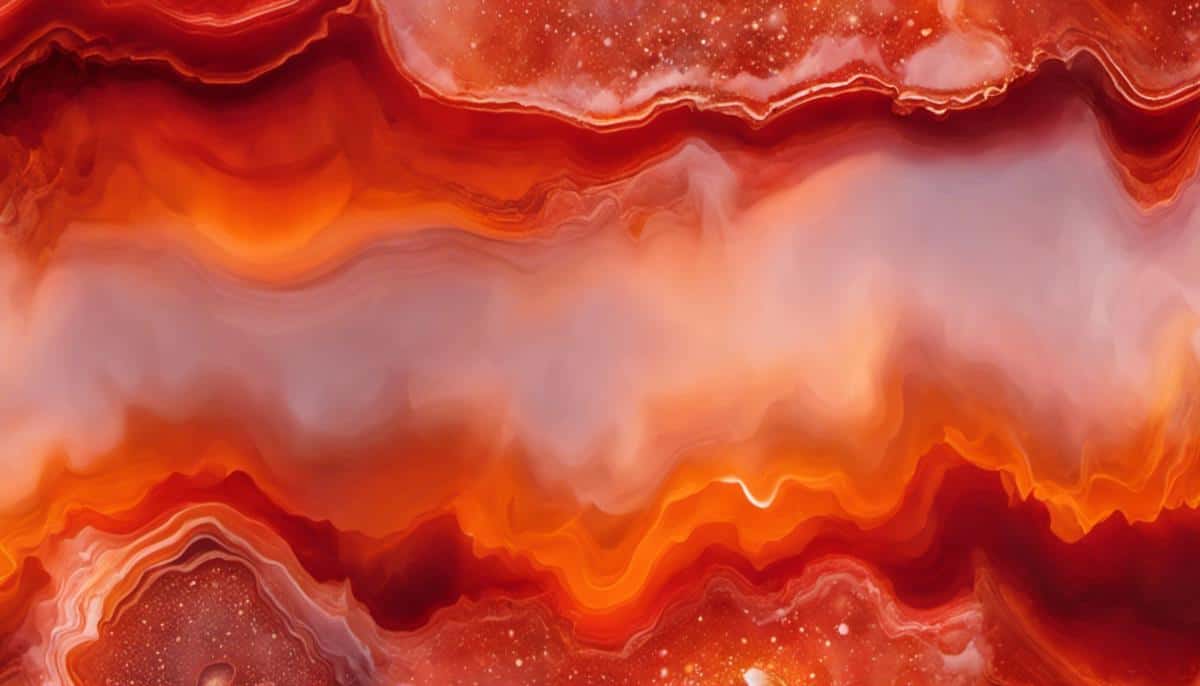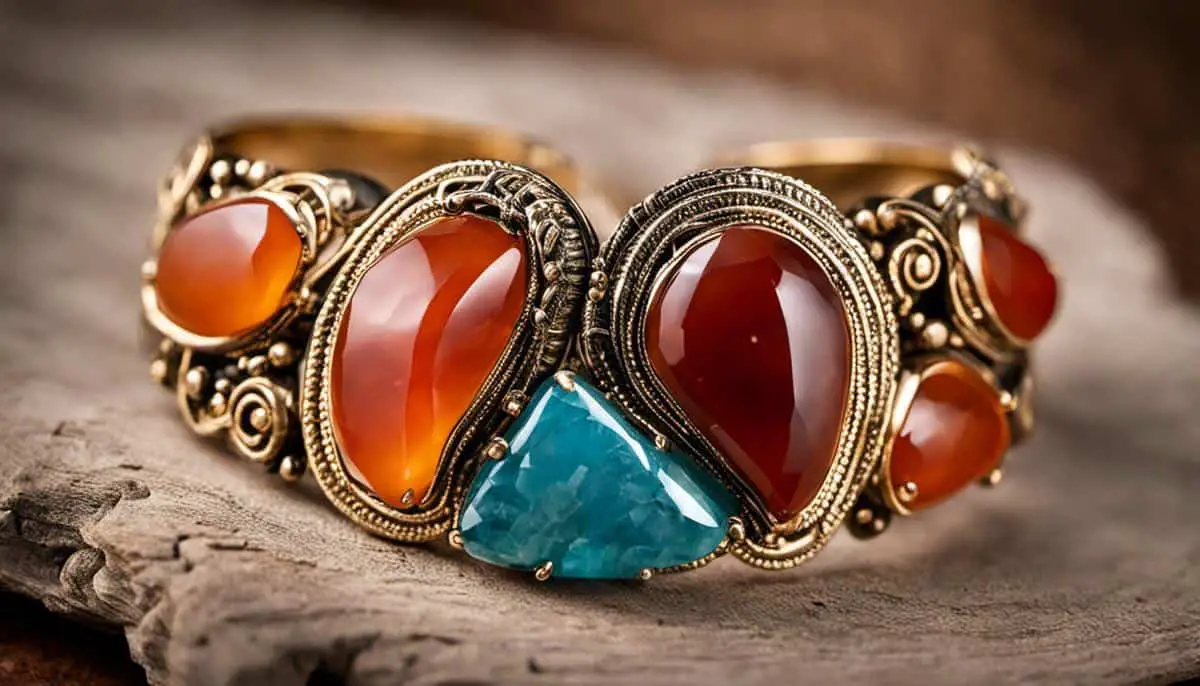Found deeply rooted across various cultures and civilizations, the Carnelian stone carries a rich history and remarkable characteristics. Its vibrant energy and healing properties have sparked intrigue and have found particular significance within the realm of chakras, energy centers of our body as per Hindu tantrism. This analysis provides a comprehensive look at the petrological aspects of carnelian, its historical usage, and its relation to the sacral chakra, allowing for a broad understanding of this fascinating stone. Moreover, it examines the evidence, both scientific and anecdotal, supporting Carnelian’s healing powers and showcases how this gemstone can be practically incorporated into everyday life.
Carnelian Stone: An Overview
The Historical and Geological Significance of Carnelian Stone
Originally known as “Cornelian,” the Carnelian stone holds immense geological interest. Its rich history, stretching back to ancient times across cultures, underscores its unique value both as an object of adornment and a bearer of profound symbolism.
Geologically, Carnelian is a variety of chalcedony, a microcrystalline form of Quartz (SiO2) grouped in the cryptocrystalline quartz family. Its distinguishing reddish-orange hue results from the presence of iron impurities, specifically iron oxide. Ranging from semi-transparent to almost opaque, this variation in opacity depends on the size and dispersion of its microcrystals. The principal localities of Carnelian encompass locations of historical significance, such as India, Saudi Arabia, and Egypt, portending the stone’s storied past.
Historically, Carnelian’s significance is equally intriguing. Its use extends back to ancient civilizations, with examples dating back to 1800 BC unearthed in Crete. This lends evidence to its early significance as a decorative gem. The Ancient Egyptians held Carnelian in high regard, aligning it with the setting sun; a symbol of regeneration. They often used it to craft jewelry and talismans believed to bestow protection in the afterlife.
Significant as well was the use of Carnelian in Ancient Rome. Here, it was a prized stone for creating engraved gems, signets, or seal rings for imprinting a seal with wax on correspondence or other important documents, thus preserving the wearers’ identity. Its resilient hardness and resistance to weathering made it an ideal material for this purpose.
Further east, in the Indus Valley Civilization, Carnelian was a key component in bead making, a testament to the stone’s visual allure and malleability. In Islamic culture, Prophet Muhammad is said to have worn a Carnelian seal ring, further insinuating the symbology and esteem vested in this precious gem.
Beyond the boundary of artistic expression, Carnelian’s warm, vibrant energy has long been associated with aspects of life energy and vitality in various cultures. It was believed to enhance courage, stimulate motivation, and promote positive life choices.
Thus, the Carnelian stone is more than just an object for aesthetic admiration. Its historical and geological significance provides a fascinating testament to the stone’s journey over time. Whether through human history or the formation in the depths of the earth, Carnelian imparted significant value and continues to awe us with its charm and profound symbology.
Wherever this vibrant stone appears in the annals of history, it commands reverence and stimulates intrigue. This confluence of history and geology contributes to the intrigue of the Carnelian stone, making it a remarkable specimen to scholars in both historical and geological realms.

Carnelian and its Relation to Chakras
The Mystic Path from Carnelian to the Chakras: A Scientific Expedition
Resolving the mystery of the human body and its various energy points – Chakras, an ancient Sanskrit term translating to ‘wheel’ – is a subject of immense intrigue. Peering through the lens of geoscience and holistic wellness, an interesting correlation can be discerned between the Carnelian- a semi-precious gemstone, and the human body’s chakras.
The energy array coiling through the human system is paralleled by seven focal points known as chakras. Carnelian is believed to corollary with two of these seven vertices, namely – the Sacral Chakra, also known as Svadhisthana, and the Root Chakra or Muladhara.
Primarily warming, the Sacral Chakra symbolizes creativity, sensuality, and emotional dynamism. An emotional fulcrum, it represents the carnelian in its capacity to stir passion, fortify vitality, and foster an atmosphere of joie de vivre. The proximate resonance of Carnelian with the Sacral chakra is scientifically profounder than a mere metaphysical accessory. Its vibrational frequencies innately correspond with the human body’s bioenergetic field, potentially impacting energy flow, mood modulation, and overall well-being.
On the other end of the spectrum, we find the Root Chakra. As the name insinuates, the Muladhara is the grounding factor, stabilizing the feelings of safety, security, and connection with the physical world. Carnelian, with its earthy hue and grounding properties, recharges this chakra. Known for its restoration abilities, carnelian reinstates lost or blocked energy, re-purposing it as a gemstone of amplification.
These interactions are not random or isolated incidents; they follow a methodological pattern within the body’s bioenergetic system. Just as the waves in the ocean ebb and flow with lunar cycles, the Carnelian’s vibrational frequency harmonizes with our body’s energy meridian.
However, such concepts cannot simply be accepted as hard facts without rigorous examination. To ensure scientific rigor, it is crucial to investigate the Carnelian’s veterinary frequencies, test its impact on human energy levels and advance the exploration of the stone’s geological attributes. These investigations must adhere to stringent measures of controls and blind tests, granting this arena of knowledge the scientific validity it deserves.
Ultimately, there is an exciting frontier for geoscience and physiology to converge, and the interrelation of Carnelian and our body’s Chakras embodies a thrilling manifestation of that confluence. As we continue studying, comparing, and uncovering more about this mystic-sync, let us remember that the quest for knowledge never truly ends, every answer merely opens the door to more questions and further exploration.

The Healing Power of Carnelian – Scientific and Anecdotal Evidence
Switching the lens of focus now, our discussion moves from historical and cultural references to examining Carnelian’s purported healing properties. There are significant bodies of anecdotal evidence suggesting a beneficial role of Carnelian in health and well-being; although the scientific study of these properties is still in its nascent stages.
It is interesting to note that in the world of alternative medicine, Carnelian finds an esteemed place due to its proposed ability to promote physical energy and endurance. Emanating from the concepts of Qi and Prana, eastern healing modalities like acupuncture and Reiki emphasize the significance of Carnelian as a conduit of life force energy.
The stone is said to imbibe spiritual warmth and energy, reportedly encouraging a better circulation of this ‘vital force’ throughout the body. The specific perceived benefits of Carnelian are thought to vary, ranging from improved digestion to enhanced fertility, and even a boost in courage.
What needs to be mentioned here is that much of these perspectives are derived from practices long arrived from the realm of metaphysics and are yet to be substantiated or refuted by rigorous scientific investigation. However, a lack of scientific evidence does not negate the possibility of yet-undiscovered truths about this fascinating stone.
Furthermore, leading into the intricate universe of neurobiology, there are implications suggesting that Carnelian might influence our cognitive responses. Anecdotally, individuals attribute increased concentration, sharpened analytical abilities, and even an overall sense of happiness to the influence of Carnelian. Again, empirical exploration of these claims is necessary to unearth concrete evidence.
One must not forget the integral interaction between our physical, mental, and emotional states. Could Carnelian, in fact, be a catalyst that fosters this interconnectedness within us? The sheer potential and implication of this proposition are both thrilling from a research perspective and significant in the scope of holistic health.
Yet, one must exercise caution in these determinations so that the line between scientific bodily functions and metaphysical belief systems is not blurred. It is crucial to understand that the present discourse does not dismiss traditional or alternative healing practices nor promote Carnelian as a guaranteed remedy.
The quest for scientific proof, in this case, is much akin to a treasure hunt with Carnelian at the source. There are mysteries yet to be unraveled and truths to be discovered. It beckons experts and researchers from various disciplines to join this quest. Only through diligent research, questioning, and collaborative explorations can we hope to answer the question:
Does Carnelian indeed possess powerful healing properties?
This question remains as enthralling as it is complex, promising a world of intrigue and discovery. Who knows what profound wisdom lies beneath the glossy sheen of the Carnelian stone? For the answers, we must turn to the realm of dedicated scientific inquiry. One can only anticipate what marvels these magnificent stones continue to reveal about the unexplored synergies between Earth’s crust and human life.

Practical Use of Carnelian in Everyday Life
Carnelian stones, renowned for their vibrant and captivating allure, have piqued the interest of the scientific, historical, and metaphysical communities alike. In the realm of Eastern healing modalities, this enthralling gemstone holds a prominent place. Believed to harbor significant energy fields, Carnelian is thought to correspond with the body’s chakra system, particularly the Sacral and Root Chakras, exerting beneficial effects on the user.
This claim does not escape the rigid scrutiny of scientific purview, however. Dedicated to evaluating claims based on empirical evidence and stringent protocols, it must be acknowledged that there is currently a dearth of definitive scientific proofs attesting to Carnelian’s purported healing properties. Alas, the lack of concrete evidence does not completely debunk the existence of a phenomenon. Uncharted territories still punctuate the broad canvas of the scientific world, necessitating relentless exploration and examination.
Notwithstanding the insufficiency of solid scientific evidence, synergistic observations and anecdotal accounts from users suggest that Carnelian may influence cognitive responses. In the context of chakra balancing, it is reported to induce a sense of calm, enhance concentration, and stimulate creativity. There is a conceivable interconnection between our physical, mental, and emotional states that Carnelian could potentially influence. However, any reference to such effects should not mislead readers into adopting an uncritical acceptance of metaphysical belief systems as scientific functions, or vice versa. It is important that the boundary between these distinct realms is respected.
Interestingly, the quest to substantiate the healing attributes of Carnelian goes beyond mere curiosity and enjoyment; it illuminates the overarching goal of aggrandizing scientific wisdom. While existing research and understanding may fall short of identifying a definitive link between Carnelian’s properties and therapeutic benefits, the scientific fraternity is threaded by an enduring hallmark – the quest for knowledge. Thus, a lack of present evidence generates not skepticism but, rather, the anticipation of ultimately striking upon undiscovered truths.
Carnelian’s potential influence on chakra balancing and overall well-being, although not currently corroborated by tangible scientific evidence, is an intriguing question. The answer could mark a fascinating convergence of geoscience and physiology, opening a new chapter in the scientific understanding of these intriguing stones. Thus, the journey to decipher the marvels of Carnelian continues, fuelled by rigorous scientific inquiry and the steadfast hope of unearthing newfound wisdom in the future.

Ultimately, the power of carnelian is deeply intertwined with its vibrant history and its profound connection with the sacral chakra. The remarkable healing properties attributed to this stone find affirmation in various scientific studies and personal anecdotes, further propelling its significance in the spectrum of energy healing.
Practical methods of integrating carnelian into our lives, such as in jewelry, meditation aids, or contemplative practices, make this gemstone not merely a historical relic, but a modern tool for chakra balance. This exploration of carnelian, hence, provides a pathway for every individual seeking its potent benefits, thus bridging the gap between the abstract and concrete realms of energy healing.



